Apple's 15-inch Core i5 MacBook Pro: The One to Get?
by Anand Lal Shimpi on April 14, 2010 10:38 PM EST- Posted in
- Mac
- MacBook Pro
- Arrandale
- Core i5
- Laptops
They’re Actually Faster
Benchmarking under OS X isn’t difficult, you just need to get creative. Luckily I’m in dire need of creative outlets so creating OS X benchmarks works for me. I’m using the same tests I introduced in my Holiday 2009 Macbook Pro roundup and running on the same hardware (specs listed in the tables on the previous pages). The Core i5 system is the new entry level 15-inch MacBook Pro.
We’ll start with general application performance.
General OS usage is a difficult thing to quantify, but one measure of performance has always been the number of bounces an icon in the dock makes before an application loads. I decided to take it to the next level and write a quick script to launch 15 applications in a row, timing how long the entire process takes.
I launched, in order: Mail, Safari, Activity Monitor, iTunes, iCal, DVD Player, iPhoto, Photo Booth, Quicktime Player, Disk Utility, Preview, iMovie, Front Row, Garage Band and Aperture.
The entire process stresses both the disk and CPU, which is why we see a huge improvement when going to an SSD as well as differences between CPU speeds.
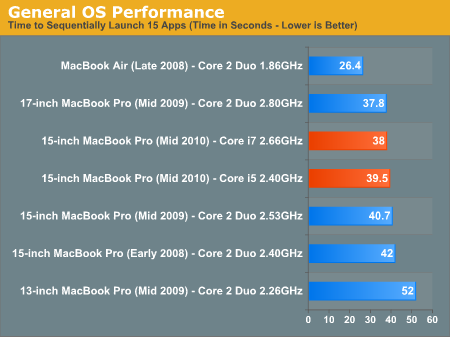
My application launch test absolutely rocks on the MacBook Air because it ships with an SSD by default. The MacBook Pros are stuck with mechanical hard drives and thus don’t perform nearly as well. If you’re curious, installing an Intel X25-M G2 in any of the MBPs will drop their times to 16 seconds or less.
The new MacBook Pro also doesn’t improve performance that much. I measured a 3% increase in performance, which although repeatable, isn’t really spectacular. This is compared to the old 2.53GHz Core 2 Duo and should serve as a baseline for the minimum performance improvement you should see. In other words, the 2.4GHz 15-inch MacBook Pro should perform no worse than last year’s 2.53GHz model.
The $2199 model with a Core i7 running at 2.66GHz pushes performance up another 3.9% over the base model. That's actually more than I expected but the real strength of the i7 is visible in the more CPU bound tests.
Adobe Photoshop CS4 Performance
The Retouch Artists Speed Test we use for our CPU testing under Windows also works under OS X. We're running the exact same benchmark here, basically performing a bunch of image manipulations and filters and timing the entire process.
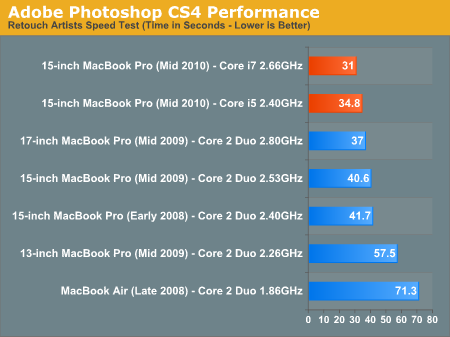
The old 13-inch MacBook Pro is penalized by only shipping with 2GB of memory, which is why it performs so poorly here. The real comparison is between the 2.4GHz Core i5 vs. the 2.53GHz Core 2 Duo from last year. The former is 16.6% faster in our Photoshop test. In fact, the new 15-inch MacBook Pro is even faster than the older 2.80GHz 17-inch model I reviewed.
The Core i7 model is 12.3% faster than the baseline Core i5 2.40GHz. Definitely noticeable.
Aperture 2 RAW Import
For my Aperture test I simply timed how long it took to import 203 12MP RAW images into the library.
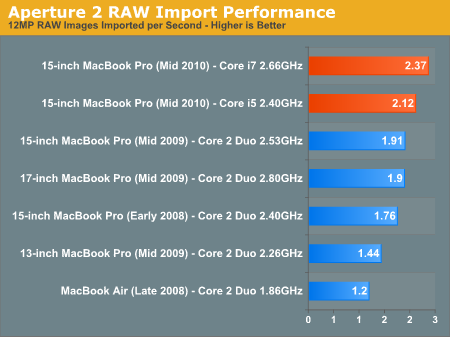
The new entry level 15-inch MBP is 10.9% faster than the old MacBook Pro, and again, it’s faster than the old 17-inch model as well. Moving to the Core i7 gives you another 11.8%.
Cinebench R10
I’m a fan of the Cinebench test because it lets me show off both single and multithreaded performance in the same workload. First, the single threaded performance:
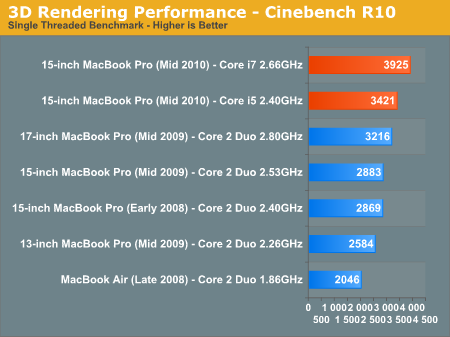
Here we have a huge advantage on the new MacBook Pro. Intel’s Turbo Boost is active here, resulting in a large performance advantage, not to mention all of the enhancements present in the Nehalem/Arrandale architectures. This is one of the best situations for the Core i7 vs. the i5. The extra $400 gives you another 14.7%, not bad at all.
Multithreaded performance is equally impressive:
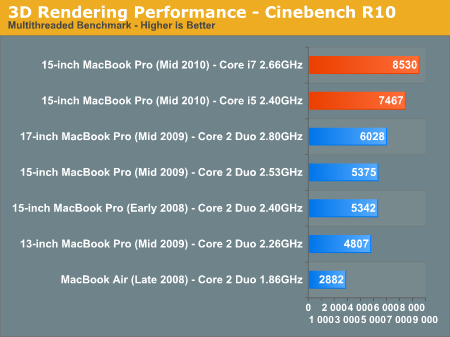
Thanks to Hyper Threading, the new Core i5 puts a generational gap between itself and last year’s MacBook Pro in this test. Whether you’re running single threaded or multithreaded applications, the Core i5 can be noticeably faster than the Core 2 Duo.
Quicktime H.264 Video Encoding
Our final benchmark is more consumer focused. Here I'm taking an XviD and converting it to an iPhone-supported H.264 format.
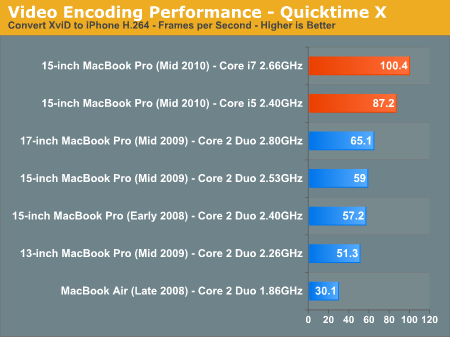
Video encoding is one of the i5’s definite strengths. If you do a lot of video encoding on your notebook, the jump from Core 2 to i5 is tremendous - approaching 50% in this case even despite the “lower” default clock speed. This is also the best showing for the Core i7 - count on an extra 15% over the base Core i5.
Core i7 vs. Core i5 Performance Summary
The two Core i5 models Apple offers ship with a 2.40GHz or 2.53GHz processor, both with a 3MB L3 cache. The $2199 15-inch MacBook Pro comes with a 2.66GHz Core i7, with a full 4MB L3 cache. Compared to the entry level model that's an 11% increase in clock speed and a 33% increase in L3 cache.
While I don't believe there's much reason to go for the 2.53GHz over the 2.40GHz model (L3 cache size remains the same, clock speed goes up by a small amount), the Core i7 is actually pretty decent. For a 22% increase in total system cost you end up with 11 - 15% better performance in CPU bound applications. It actually even feels snappier in general use as well.
I'd still suggest opting for an SSD before considering any CPU upgrades, but if you're looking to keep your new MacBook Pro for a while the Core i7 is worth it.










114 Comments
View All Comments
anactoraaron - Thursday, April 15, 2010 - link
Arrandale CULV 13-14" 1440x900 res with discrete ATI 5770mobile + GPU switching.... Imagine having up to 10+ hrs battery life for light internet, word processing work related tasks, being able to watch 2-3 dvd's on battery and then plugging in to game on very high for almost every game! CPU would be 1.3-1.5ghz on battery and "prefer" to run everything single threaded and would run upwards of 2.0ghz "preferring" to be multi-threaded plugged in. That's what I'm waiting for.... the next gen of CULV + Centrino. Can't wait.By the way, it's pretty sad that even you Anand are making comments on Apple's prices (since you love Apple the way you do). Guess all relationships that are good eventually become more "Love-Hate"
l0ts - Thursday, April 15, 2010 - link
I Wonder what difference can You find between GT330M and GT240M.I checked my GT240M in GPU-Z and looks like i got "GT330M "with higher clocks. In six months i'll probably have GT420M. :)
Thanx NVIDIA!
Jamahl - Thursday, April 15, 2010 - link
Who buys this overpriced garbage?TEAMSWITCHER - Thursday, April 15, 2010 - link
Myself, and a lot of people. I have a late 2006 MacBook Pro that was the first with a Core 2 Duo chip. I have been waiting for the first MacBook pro with a Core i5/i7 processor. This new machine looks exactly like the replacement I have been waiting for. Thank you Anand for the great (and very timely) review.ppayne - Sunday, April 25, 2010 - link
I buy Macs and am happy to. I run a business and the improved reliability of the Mac means they pay for themselves very quickly. I use my laptop about 8 hours a day (that's on top of my normal work, which I use a Mac Pro for) and any improvement in my workflow is worth a paltry $2000 to my company. If we had PCs at my company I'm sure we'd have a tech guy on payroll who kept things running by now (15 employees). Since I can literally take a hour a month to go around and make sure all updates are run on our Macs instead, there's a pretty clear savings over options we could choose (Windows, "free" Linux etc). Time, convenience, and reliability are actually worth *some* money you know?Not everyone is a college student/hobbyist/penny pinching type, although clearly you (and other commenters here) are hating for the sake of hating. For the record, I do PC software development and database work on the Mac and love the irony of not having to keep crap PCs around work to get work done.
rumimonkey - Thursday, April 15, 2010 - link
I'm curious for Anand's (or others') thoughts regarding the glossy screens... I'm looking to get my first MBP, and would prefer the 13" (in spite of the C2D). However, I was hoping for a matte option on the smaller model. Is this litmus test really good enough: indoor = glossy, outdoor = matte? I want the 13" because I'd like to be truly mobile, and thus will be beholden to variable lighting conditions. And so if I'm in a public (indoor) place trying to write or read online, what will my experience be? Or if I'm working on the couch at home with the blinds open (hey, I like sunshine), would the gloss drive me bonkers and cause eye strain? Thanks in advance to all who (hopefully) respond with comments and recommendations.kmmatney - Thursday, April 15, 2010 - link
I have a Dell with the upgraded, glossy screen, and its great in all situations indoors. As long as you can avoid any direct reflections from light sources, a glossy screen is much better indoors, IMO. I've been able to use mine outdoors as well - just need to find some shade.T2k - Thursday, April 15, 2010 - link
... and you can answer your question, which one to get. :)http://bit.ly/acer750
quiksilvr - Thursday, April 15, 2010 - link
Actually, if you get the base 15" model, its $150 extra, because they don't offer 320GB HDD at 7200rpm.That is a complete insult. Not only are these things ridiculously overpriced (and their performance isn't even that great for the price either), their upgrades are an insult. Its not like these are magical iPod HDDs. These are the SAME HDDs available on HP and Dell computers. At HP, you can upgrade from a 160GB 5400RPM HDD to a 250 7200RPM HDD for only $30.
And don't even get me started on their lack of ports. No SD slot on the 17" model? No eSATA? No Blu Ray? Correct me if I'm wrong, but aren't these laptops intended for the PROfessional field?
ReaM - Friday, April 16, 2010 - link
I agree with you.I have had 10 macs in my life, currently macbook pro and imac.
This update is ridiculous. The extra cost for the - what now is standard display - is hilarious.
The only update worth considering is the base 13 inch. But still no i5 nor i3 in it and no display bump up.
As I wrote, for 1700 buck you can build i7 980X system (hackintosh, if you will) - just as a comparison.
The current macs are not worth the money.
Last worthy update was the when unibodies were introduced. But since then, two years went by and nothing changed, except of higher price